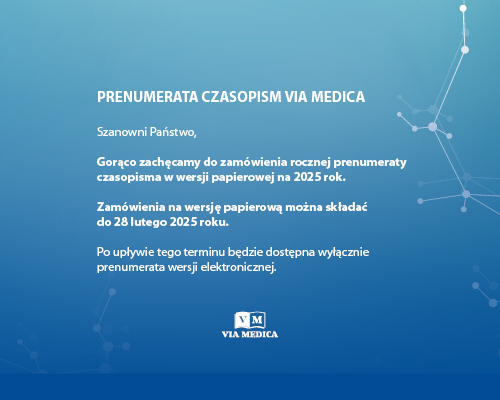Vol 62, No 3 (2011)
Original paper
Published online: 2011-06-29
Graves’ ophthalmopathy in patients treated with radioiodine 131-I
Endokrynol Pol 2011;62(3):214-219.
Abstract
Background: Radioiodine treatment of hyperthyroidism in Graves’ disease patients may cause or aggravate the course of ophthalmopathy
(GO). We evaluated the activity and severity of ophthalmopathy in patients who acquired GO following radioiodine therapy.
Material and methods: Between 2003 and 2005, 763 Graves’ disease patients (50.9% of the total number of 1,500 patients referred to our Department) were treated with radioiodine 131-I. This treatment was only offered to patients with NOSPECS score < 3 and CAS < 3. Following their radioiodine treatment, in 39 patients (5.1% of all Graves’ disease patients), mean age 53.9 ± 11.6 years, onset of GO was observed within 12 months of post-treatment follow-up.
Results: In 39 patients who developed GO after 131-I treatment, median values of hTRAb and NOSPECS score were 15.4 U/L (IQR = 22.9) and 5.0 points (max = 8.0; min = 2.0), respectively, at the time of their GO onset. Patients were qualified for methylprednisolone pulse therapy (8.0 g) and subsequent radiotherapy (20 Gy). Median concentration of hTRAb and NOSPECS score at one, six and 12 months post-GO therapy were: 10.0 U/L (IQR = 21.6) and 4.0 (max = 6.0; min = 1.0); 7.5 U/L (IQR = 1.1) and 3.0 (max = 10.0; min = 0.0); 2.8 U/L (IQR = 8.3) and 3.0 (max = 6.0; min = 0.0), respectively. A positive association between hTRAb and NOSPECS score was observed over the control period. IL-6 and IL-2 concentration prior to and one month after treatment remained elevated.
Conclusions: Since 5% of our Graves’ disease patients developed severe GO following radioiodine treatment, an association between radioiodine therapy and severe ophthalmopathy cannot be excluded. IL-6 and IL-2 concentrations remained elevated after glucocorticoid therapy. (Pol J Endocrinol 2011; 62 (3): 214–219)
Material and methods: Between 2003 and 2005, 763 Graves’ disease patients (50.9% of the total number of 1,500 patients referred to our Department) were treated with radioiodine 131-I. This treatment was only offered to patients with NOSPECS score < 3 and CAS < 3. Following their radioiodine treatment, in 39 patients (5.1% of all Graves’ disease patients), mean age 53.9 ± 11.6 years, onset of GO was observed within 12 months of post-treatment follow-up.
Results: In 39 patients who developed GO after 131-I treatment, median values of hTRAb and NOSPECS score were 15.4 U/L (IQR = 22.9) and 5.0 points (max = 8.0; min = 2.0), respectively, at the time of their GO onset. Patients were qualified for methylprednisolone pulse therapy (8.0 g) and subsequent radiotherapy (20 Gy). Median concentration of hTRAb and NOSPECS score at one, six and 12 months post-GO therapy were: 10.0 U/L (IQR = 21.6) and 4.0 (max = 6.0; min = 1.0); 7.5 U/L (IQR = 1.1) and 3.0 (max = 10.0; min = 0.0); 2.8 U/L (IQR = 8.3) and 3.0 (max = 6.0; min = 0.0), respectively. A positive association between hTRAb and NOSPECS score was observed over the control period. IL-6 and IL-2 concentration prior to and one month after treatment remained elevated.
Conclusions: Since 5% of our Graves’ disease patients developed severe GO following radioiodine treatment, an association between radioiodine therapy and severe ophthalmopathy cannot be excluded. IL-6 and IL-2 concentrations remained elevated after glucocorticoid therapy. (Pol J Endocrinol 2011; 62 (3): 214–219)
Keywords: Graves’ ophthalmopathyradioiodine treatment



